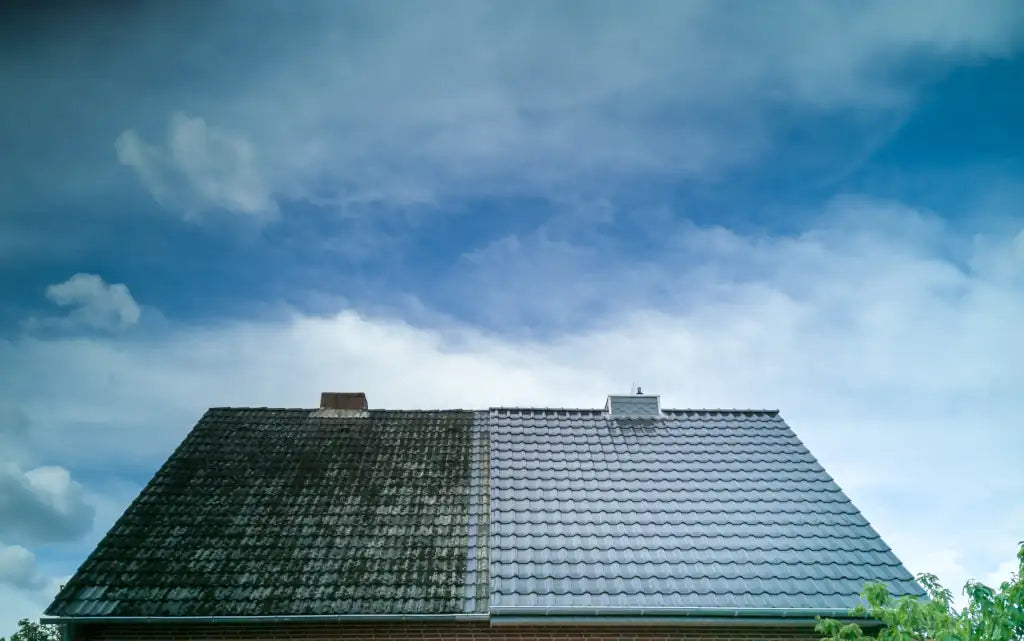Cleaning a tiled roof is something we often recommend not just for improving appearance, but for maintaining the longevity and structural health of a property. Over time, tiled roofs collect moss, algae, lichen, dirt and debris – all of which can shorten the life of the tiles and affect drainage. We’ve seen first hand how neglected roofs become vulnerable to water ingress, frost damage, and general wear and tear. A clean roof is a safer, more durable one, and regular maintenance plays a key role in protecting your investment.
In our experience, many homeowners put off cleaning because they’re concerned about causing damage or simply unsure where to start. That’s understandable – roof tiles can be fragile, especially on older properties, and the wrong technique can result in cracked tiles, dislodged fittings or ineffective results. But with the right approach and the correct tools, tiled roof cleaning can be carried out safely and effectively.
Why Should You Clean a Tiled Roof?
There are several good reasons we always recommend tiled roof cleaning as part of routine maintenance. One of the main concerns is moss. Moss holds moisture, and when temperatures drop, that trapped moisture freezes and expands, potentially cracking tiles and mortar.
Another reason is drainage. Dirt, leaves, and biological growth can obstruct rainwater flow, leading to water pooling or backflow beneath tiles. This creates ideal conditions for leaks and mould in the loft space. By cleaning the roof, you're allowing water to run off as intended, reducing the risk of long-term damage.
Safe Cleaning Methods for Tiled Roofs
The most appropriate cleaning method depends on the condition of the roof, the type of tiles, and the nature of the build-up. We avoid high-powered pressure washing due to the damage these petrol or diesel powered pressure washes can cause. Many tile manufacturers and roofing bodies in the UK, such as the National Federation of Roofing Contractors (NFRC), advise against pressure washing due to the risk of stripping protective coatings or loosening tiles.
Instead, we often recommend:
-
Manual brushing: This involves physically removing moss and debris using a stiff brush and scraper. It’s labour-intensive, but it gives the best control and avoids damaging the tiles.
-
Low-pressure biocide treatments: Once debris is removed, we usually apply a biocide solution to kill off remaining spores. This helps prevent regrowth and keeps the roof cleaner for longer.
-
Soaking and rinsing: In some cases, soaking the roof with water and allowing gentle rinsing over time is sufficient, particularly for loose dirt and lichen.
Any method we use is always preceded by a roof inspection. We've found that treating a roof without checking tile condition first is a recipe for damage. Broken tiles or loose ridges need to be addressed before any cleaning begins.
Common Mistakes to Avoid
We’ve seen many well-intentioned homeowners attempt DIY cleaning, only to run into issues. Common problems include cracked tiles from walking on the roof without proper access equipment, clogged gutters due to dislodged moss, or worse, water damage from jet washing into gaps and overlaps.
Another issue is the use of acidic products or other harsh chemicals. These can corrode tiles, harm nearby vegetation, and even void warranties. We always stick to using cleaning agents we trust, and whenever possible, we opt for environmentally friendly solutions that are biodegradable and safe for pets and gardens.
Safety is another big factor. Working at height without the proper equipment or experience is dangerous. That’s why we always recommend using a professional service if you’re unsure – not just for peace of mind, but because we've seen the difference that skilled work makes.
How Often Should You Clean a Tiled Roof?
There’s no fixed rule, but in general, we advise inspecting your roof every year and considering a full clean every 3–5 years, depending on the surrounding environment. Properties in shaded areas or near large trees will likely need more frequent attention. Some of our clients opt for bi-annual moss treatments, especially if they’ve had previous issues with regrowth.
It's also worth noting that cleaning ties into broader maintenance work. When we clean a roof, we often identify other concerns like broken flashing, slipped tiles, or blocked valleys – things that can be addressed early to prevent costly repairs later.
Final Thoughts
Tiled roof cleaning is an essential part of maintaining your property’s health and value. From improving drainage and appearance to preventing more serious issues, it’s an investment worth making.
For more authoritative advice, bodies like Which? and TrustMark in the UK provide guidance on hiring qualified roof cleaning specialists. And if you’re considering a professional service, it’s always worth asking for a detailed plan – including inspection, method and aftercare.
Ultimately, we've found that staying ahead of the problem through regular cleaning is far more cost-effective than dealing with the aftermath of a neglected roof. A clean tiled roof doesn’t just look better – it works better.



